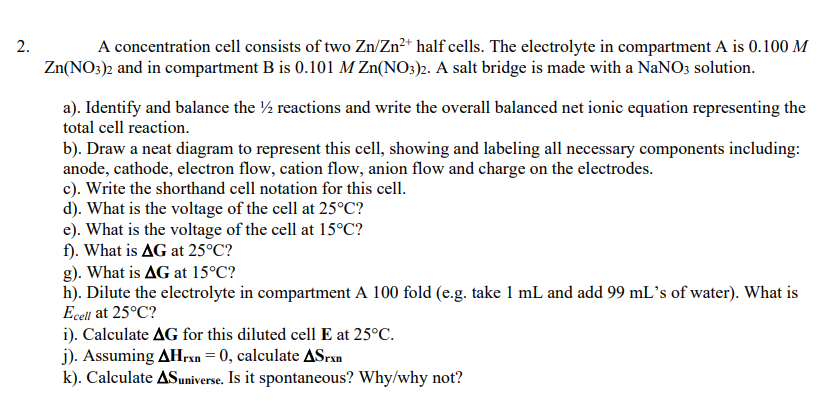A concentration cell consists of two Zn/Zn²* half cells. The electrolyte in compartment A is 0.100 M Zn(NO:)2 and in compartment B is 0.101 M Zn(NO3)2. A salt bridge is made with a NANO3 solution. 2. a). Identify and balance the ½ reactions and write the overall balanced net ionic equation representing the total cell reaction. b). Draw a neat diagram to represent this cell, showing and labeling all necessary components including: anode, cathode, electron flow, cation flow, anion flow and charge on the electrodes. c). Write the shorthand cell notation for this cell.
A concentration cell consists of two Zn/Zn²* half cells. The electrolyte in compartment A is 0.100 M Zn(NO:)2 and in compartment B is 0.101 M Zn(NO3)2. A salt bridge is made with a NANO3 solution. 2. a). Identify and balance the ½ reactions and write the overall balanced net ionic equation representing the total cell reaction. b). Draw a neat diagram to represent this cell, showing and labeling all necessary components including: anode, cathode, electron flow, cation flow, anion flow and charge on the electrodes. c). Write the shorthand cell notation for this cell.
Chapter18: Electrochemistry
Section: Chapter Questions
Problem 83E: Consider a concentration cell that has both electrodes made of some metal M. Solution A in one...
Related questions
Question
All sections please

Transcribed Image Text:A concentration cell consists of two Zn/Zn²* half cells. The electrolyte in compartment A is 0.100 M
Zn(NO3)2 and in compartment B is 0.101 M Zn(NO3)2. A salt bridge is made with a NaNO3 solution.
2.
a). Identify and balance the ½ reactions and write the overall balanced net ionic equation representing the
total cell reaction.
b). Draw a neat diagram to represent this cell, showing and labeling all necessary components including:
anode, cathode, electron flow, cation flow, anion flow and charge on the electrodes.
c). Write the shorthand cell notation for this cell.
d). What is the voltage of the cell at 25°C?
e). What is the voltage of the cell at 15°C?
f). What is AG at 25°C?
g). What is AG at 15°C?
h). Dilute the electrolyte in compartment A 100 fold (e.g. take 1 mL and add 99 mL's of water). What is
Ecell at 25°C?
i). Calculate AG for this diluted cell E at 25°C.
j). Assuming AHrxn= 0, calculate ASran
k). Calculate ASuniverse. Is it spontaneous? Why/why not?
Expert Solution
This question has been solved!
Explore an expertly crafted, step-by-step solution for a thorough understanding of key concepts.
This is a popular solution!
Trending now
This is a popular solution!
Step by step
Solved in 4 steps with 1 images

Knowledge Booster
Learn more about
Need a deep-dive on the concept behind this application? Look no further. Learn more about this topic, chemistry and related others by exploring similar questions and additional content below.Recommended textbooks for you


Chemistry: An Atoms First Approach
Chemistry
ISBN:
9781305079243
Author:
Steven S. Zumdahl, Susan A. Zumdahl
Publisher:
Cengage Learning

Chemistry
Chemistry
ISBN:
9781305957404
Author:
Steven S. Zumdahl, Susan A. Zumdahl, Donald J. DeCoste
Publisher:
Cengage Learning


Chemistry: An Atoms First Approach
Chemistry
ISBN:
9781305079243
Author:
Steven S. Zumdahl, Susan A. Zumdahl
Publisher:
Cengage Learning

Chemistry
Chemistry
ISBN:
9781305957404
Author:
Steven S. Zumdahl, Susan A. Zumdahl, Donald J. DeCoste
Publisher:
Cengage Learning

Chemistry by OpenStax (2015-05-04)
Chemistry
ISBN:
9781938168390
Author:
Klaus Theopold, Richard H Langley, Paul Flowers, William R. Robinson, Mark Blaser
Publisher:
OpenStax

Principles of Modern Chemistry
Chemistry
ISBN:
9781305079113
Author:
David W. Oxtoby, H. Pat Gillis, Laurie J. Butler
Publisher:
Cengage Learning

Chemistry: The Molecular Science
Chemistry
ISBN:
9781285199047
Author:
John W. Moore, Conrad L. Stanitski
Publisher:
Cengage Learning